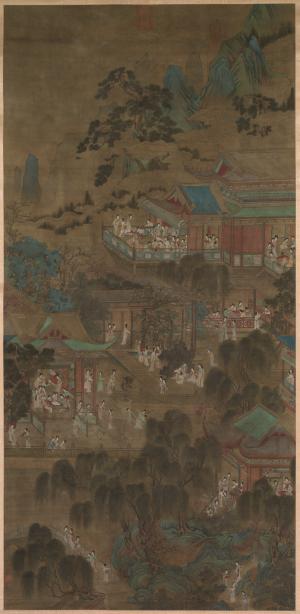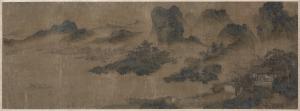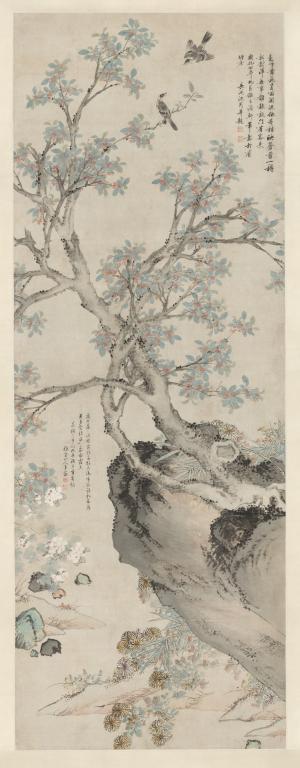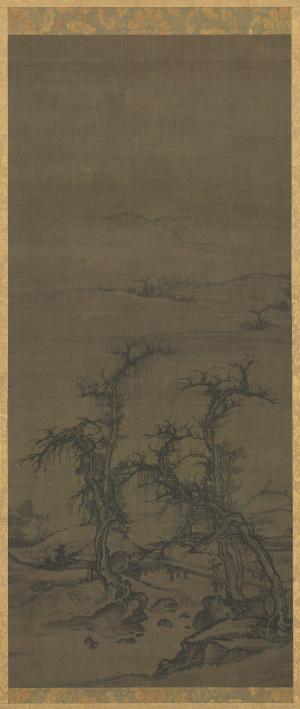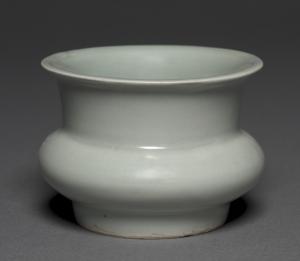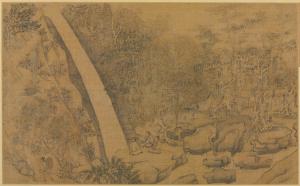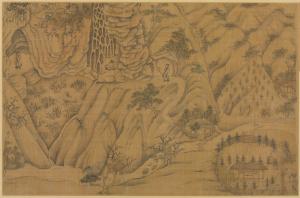In the Palace
詳細資料
John L. Severance Fund
?-1143Zhang Cheng 張澂 [d. 1143]
?-1509?Shen Zhou 沈周 [1427–1509]
early 1900s(C. T. Loo & Co., New York, NY)
before 1928-1976The University Museum, The University of Pennsylvania, Philadelphia, PA, sold to the Cleveland Museum of Art
1976-The Cleveland Museum of Art, Cleveland, OH
Painting: 28.5 x 168.6 公分 (11 1/4 x 66 3/8 英吋)
Overall: 29.7 x 306.1 公分 (11 11/16 x 120 1/2 英吋)
絹本
1 colophon and 13 seals: 1 colophon and 1 seal of Zheng Cheng 張澂 (d. 1143); 12 seals unidentified.
Colophon by Zhang Cheng 張澂 (d. 1143):
周文矩宮中圖婦人小兒其數八十,一男子寫神,而粧具、樂器、盆盂、扇椅席、鸚鵡、犬蝶不與。文矩句容人,為江南翰林待詔。作士女體近周昉,而加纖麗。嘗為後主畫南莊圖,號一時絕筆。它日上之朝廷,詔籍之祕閣。宮中圖云是真蹟,藏前太府卿朱載家。或摹以見餽。婦人高髻自唐以來如此。此卷豐肌長襦裙,周昉法也。予至嶠南,於端溪陳高祖之裔,見其世藏諸帝像,左右宮人梳髻與此畧同。而丫鬟乃作兩大鬟,垂
肩項間,雖醜而有真態。李氏自謂南唐,故衣冠多用唐制,然風流寔承六朝之餘。畫家者言辨古畫當先問衣冠車服,蓋謂是也。紹興庚申五月乙酉澹嵒居士題。
印:張澂印章
[This is] Zhou Wenju’s painting, In the Palace. [In this scroll], women and children number eighty, with a single man. All are drawn to life, not to mention such matters as cosmetic accessories, musical instruments, pots and pans, fans, chairs, mats, parakeets, dogs, and butterflies. Wenju was a native of Jurong. He served as a Hanlin Daizhao [painter-in-waiting] in the south. In figure painting, his style is akin to Zhou Fang’s [active 8th century], but adding a touch of exquisiteness. He once painted a painting titled Southern Villa for Li Houzhu, a painting that was praised at the time as a supreme achievement. In later days, it was presented to the [Song] court and was much cherished in the imperial pavilion [library]. In the Palace was said to be a genuine work by him. It had been in the collection of Zhu Zai, the former Chamberlain for Palace Revenue. Perhaps he had a copy made as a gift, [which is the scroll that I saw]. Women here are depicted with tall chignons, such being the fashion since the Tang dynasty. This scroll presents them with full bodies and also long trailing skirts—this was indeed Zhou Fang’s approach. When in Qiaonan, I visited the descendents of Emperor Gaozu [r. 618–626] of the Chen [dynasty] at Duanxi [near Gaoyao xian, Guangdong province] and saw with my own eyes their family collection of imperial ancestors. The attendant ladies at the sides of these Emperors had the same hairdo as is seen here. The palace servants were shown with two large loops hanging between the neck and shoulder. Although these hairstyles looked ugly, they do appear quite real indeed. The House of Li called its own dynasty Southern Tang; consequently, in matters of fashion, they adhered to the Tang mode. Yet in terms of their cultural origins, they were inheritors of the Six Dynasties. It is the insight of those painters who believed that, in appraising ancient paintings, the first priority lies in the discernment of costumes, furnishings, chariots, and so on. This is indeed the case. On the yiyou day of the fifth moon, the gengshen year of the Shaoxing era, Tanyan Jushi inscribed this.
Seal: “Zhang Cheng yin zhang” [seal inadvertently impressed upside down].
水墨設色



